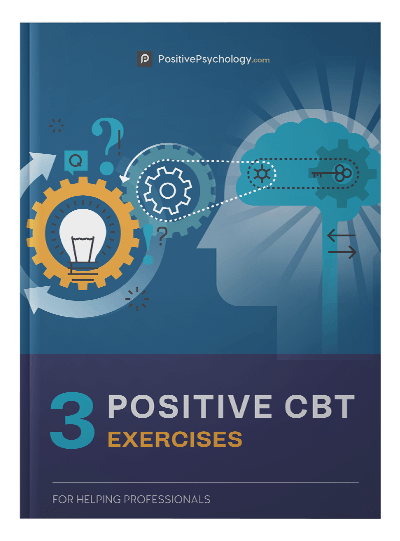How Does Paradoxical Intention Really Work in Therapy?
 More than 40 million adults in America live with anxiety.
More than 40 million adults in America live with anxiety.
While anxiety disorders, fear, and phobia are highly treatable, only 36.9% of those with anxiety receive the help they need (Anxiety and Depression Association of America, n.d.).
While many treatments focus on eliminating experiences of fear and anxiety, the idea behind paradoxical intention is to approach it head on. Paradoxically, instead of avoiding such emotions, the clients expose themselves to more of them (Ascher, 2002; Society of Clinical Psychology, n.d.).
This article explores this innovative approach and how we can use it to treat various mental disorders.
Before you continue, we thought you might like to download our three Positive CBT Exercises for free. These science-based exercises will provide you with detailed insight into positive Cognitive-Behavioral Therapy (CBT) and give you the tools to apply it in your therapy or coaching.
This Article Contains:
What Is Paradoxical Intention in Therapy?
Paradoxical intention, according to the American Psychological Association’s Society of Clinical Psychology, “is a cognitive technique that consists of persuading a patient to engage in his or her most feared behavior” (Society of Clinical Psychology, n.d., para. 1).
The client rehearses their anxiety-inducing thought or behavior pattern. Haven’t we all been in situations where we tried to ignore or forget thoughts and feelings, only to do the opposite?
The approach is grouped with other interventions, strategies, and techniques that fall under the definition of therapeutic paradox. Paradoxical intentions are most often paired “with responses that are impeded by recursive anxiety—a concept associated with the fear of fear” (Ascher, 2002, p. 332).
One such example, familiar to many people, is the fear of public speaking. Systematic desensitization can be a highly effective mental health treatment where triggers are external to the speaker, such as the number of people in the audience, their attributes, and their reactions. When the factors are primarily internal – and often anxiety related – paradoxical intention offers a highly effective alternative therapeutic intervention (Ascher, 2002).
Albeit counterintuitively, paradoxical intentions focus on the most salient aspect of sympathetic activity. So, suppose a client imagines that their heart rate might increase when presenting to a point where they may have a heart attack.
In that case, the behavioral intervention program encourages the client to focus on increasing their heart rate.
Paradoxically, when entering a situation where they expect to experience recursive anxiety (rather than try to remain calm), they focus on the very nature of sympathetic discomfort, such as blushing. The client is asked to enter the embarrassing situation and “really try to blush.”
The client may feel perplexed. After all, they are receiving information at odds with what they expect. They are being asked to engage with the very symptom they wish to prevent. As a result, they must be given considerable therapeutic support and full instructions on how to self-administer.
The therapeutic alliance between therapist and client is crucial: Both must be equal parties in the treatment and fully informed on what is expected (Ascher, 2002).
A Brief History: Logotherapy and Frankl

He had witnessed the worst that humanity could offer while experiencing, firsthand, the human capacity to overcome and even find meaning in extreme situations.
As a result, Frankl became passionately interested in what makes us uniquely human, based on the following central tenets (Schulenberg, 2003):
- Our lives do indeed have meaning.
- We long to experience meaning.
- We can experience that meaning in many different circumstances.
The idea of the paradoxical intervention began with logotherapy, created by Frankl as an existential approach to psychotherapy (Ascher, 2002). His therapeutic approach, adopted by many therapists since, helps people find personal meaning in their lives.
During his work with clients, Frankl noticed an anxiety cycle. When someone became scared of something, they first tried to avoid it but later became fearful of the fear itself. Paradoxical intention turns expectations on their head. Rather than avoidance, paradoxically, we must face the things that cause us worry, fear, and anxiety.
He also believed that humor could play a vital role in neutralizing any associated anxiety, enhancing the intervention’s effectiveness and administration. In a very real sense, the neurotic client has taken a significant stride toward their therapeutic goals when they can laugh at their neurotic complaints (Ascher, 2002).
How to Effectively Use the Method
Paradoxical intention is a cognitive technique that involves persuading clients to engage in their most feared behavior. The approach can help individuals experiencing anxiety, fear, phobias, eating disorders, and even depression, by encouraging them to face the fear itself (Ascher, 2002).
The role of paradoxical intention is to assist individuals with recursive anxiety – fear of the fear rather than the experience – to enhance their wished-for performance by circumventing or ignoring the goal of remaining calm (Ascher, 2002).
At a high level, clients (supported by the therapist) perform each of the following steps (Cocchimiglio, 2022):
- Identify what triggers and experiences cause them fear and anxiety.
- Find ways to make the experience bigger, heightening their emotional response.
- Place themselves in the situation rather than avoiding it. For example, if the client fears failing, they place themselves in situations where they are likely to fail.
- Repeat the process until the idea of failing (or any other fear) no longer fills them with anxiety and dread.
The approach can work in many situations and scenarios and need not be limited to those facing mental health issues (Espie, 2011).
As far back as 1985, paradoxical interventions have been used successfully to treat clients with anorexia nervosa. Therapists acknowledge the “anxiety-provoking aspects of attempting to induce weight gain” and adopt a more “passive supportive approach” toward and in their relationship with their client (Griffin, 1985, p. 263).
- The client is assured that weight gain is not desired or even expected and that a weight reduction program could be put in place if increases are excessive. Instead, the goal for the client is to establish regular healthy eating and learn about their body’s reaction to certain foods.
- The therapist only highlights positive aspects of the client’s diet, reassuring them they are being responsible. This approach offers a positive interpretation of their behavior rather than harsh criticism.
- Caution is used regarding progressing too quickly and even in gaining too much weight. Upper weight limits may be set, and the client is encouraged to “go slow.”
While not necessarily more appropriate than other techniques for treating eating disorders, fear, and anxiety-related conditions, paradoxical intentions offer an alternative and direct approach (Espie, 2011).
Using Paradoxical Intention for Insomnia

When clients stop trying to get to sleep and instead switch to staying awake for as long as they can, their anxiety levels reduce and sleep comes more easily (Society of Clinical Psychology, n.d.).
The biggest challenge to this type of therapy may come from the patients themselves. They may be skeptical or unwilling to swap from trying to get to sleep to trying to stay awake, as the approach can seem paradoxical.
The rationale of paradoxical intention regarding sleep suggests “that because sleep is essentially an involuntary physiological process, attempts to place it under voluntary control are likely to make matters worse” (Barkoukis et al., 2012, p. 164).
One such paradoxical intention approach is described using the following sleep restriction therapy guidelines (Barkoukis et al., 2012):
- The client begins by recording their sleep for two weeks in a diary to identify their average nightly sleep duration.
- Together, the therapist and client agree on a morning wake-up time (such as 7:30 a.m.).
- A new bedtime is calculated, taking the average sleep duration from the wake-up time (if the average sleep duration is five and a half hours, the bedtime becomes 2 a.m.).
- Clients are encouraged to get into bed at their new bedtime and get up at their wake-up time throughout the week and weekend.
- As the percentage of time asleep versus time in bed increases (i.e., more than 90%), the sleep window can be increased by 15 minutes. Alternatively, if the client is asleep for less than 90% of the sleep window, it can be decreased by 15 minutes.
Such paradoxically influenced approaches are successful with people with insomnia because they focus on core sleep at the cost of optional sleep while improving sleep efficiency.
Another such paradoxical approach involves trying to stay awake even when ready for sleep (Barkoukis et al., 2012):
- The client goes to bed and lies comfortably with the lights off while keeping their eyes open.
- They make no effort to fall asleep.
- They also give up any concern they have regarding still being awake (Barkoukis et al., 2012).
- When they feel themselves starting to fall asleep, and their eyes closing, they gently ask themselves to stay awake for a few more minutes (it is important not to pressure themselves at this point, but to remind themselves they will fall asleep when ready).
- The aim is for the client not to force themselves to stay awake but to shift the focus from trying to fall asleep to letting sleep come naturally.
This last approach is truly paradoxical – the guidelines appear to encourage the symptoms (insomnia and lack of sleep) that the client wants to remove. And yet, as a treatment, it works (Barkoukis et al., 2012).
Further reading: Sleep Hygiene Tips: 6 Worksheets for a Healthy Night’s Rest.
How to Apply It for Depression and Anxiety
While paradoxical techniques have proven successful with conditions such as insomnia and agoraphobia, perhaps more surprisingly and much less commonly, they have also been used with clients with depression (Thomason, 2012).
Well-known and highly honored psychotherapist Nicholas Cummings’s technique was to displace clients’ anger from themselves or a loved one toward the therapist. After all, “if one believes that a patient’s depression is really rage directed inward, then one solution is to externalize the rage” (Thomason, 2012, p. 5).
However, this approach is risky, controversial, and could be deemed reckless, especially when there is a concern that the client could attack the therapist (Thomason, 2012).
In addition, any form of paradoxical treatment should be handled carefully or even avoided when the client may identify with a suicidal impulse (Weeks, 2013).
Helping clients with OCD
While literature reviews identify only limited research that specifically mentions the use of paradoxical interventions in patients with obsessive-compulsive disorder (OCD), some studies are available.
Early research asked OCD patients to engage in the very acts that they were most afraid of, such as handling objects perceived as dirty or using swear words. The idea was that the client did not “avoid the fearful situations or escape from the anxiety-provoking thought or event” but embraced them (Solyom et al., 1972, p. 292).
Reversing the client’s thinking – making the intruding thought the willed one – might ultimately eliminate the thought.
While often using different terms, modern therapy uses similar approaches, helping clients face their fears without trying to “fix” them. Exposure and response prevention is a type of CBT that exposes the client to the triggers (thoughts, objects, situations) that start the obsessions while choosing not to react (International OCD Foundation, n.d.).
Resources From PositivePsychology.com
We have many resources available for therapists providing support to clients wishing to change their behavior.
Why not download our free Cognitive-Behavioral Therapy pack and try out the powerful tools contained within? Some examples include:
- Strength Spotting by Exception Finding
This valuable exercise helps clients learn how to become aware of their strengths relative to their goals, rather than their deficiencies relative to their problems. - Reframing Critical Self-Talk
Reducing self-criticism is an essential goal underlying many forms of psychopathology. Replacing critical self-talk with positive statements can lead to a more confident, growth mindset.
Other free resources include:
- Reward Replacement Worksheet
Use this worksheet to identify the behavior to be changed while targeting new hoped-for behavior and the potential rewards available. - Setting Internal Boundaries
This practical worksheet is used by the client to set behavior going forward and identify what is out of bounds.
More extensive versions of the following tools are available with a subscription to the Positive Psychology Toolkit©, but they are described briefly below:
- Realizing Long-Lasting Change by Setting Process Goals
Goals differ in the duration of involvement needed for their achievement. This tool is designed to aid clients in the formation, definition, statement, and pursuit of process goals.
-
- Step one – Choose and capture the change.
- Step two – Focus on what action is needed to realize this change.
- Step three – Consider the habits to underpin the long-lasting change.
- Step four – Start taking the action, no matter how small.
- Changing Behavior Through Positive Reinforcement
Positive reinforcement is one of the most effective ways to promote behavior change and can be used to replace unwanted behaviors with more desirable ones.
This exercise supports clients as they reinforce desirable behaviors and cultivate new positive behavior patterns using small, immediate rewards.
-
- Step one – Identify a behavior to reinforce.
- Step two – Find and select a suitable reward.
- Step three – Having rewarded your behavior, reflect on the positive feelings and the practice of changing behaviors.
If you’re looking for more science-based ways to help others through CBT, check out this collection of 17 validated positive CBT tools for practitioners. Use them to help others overcome unhelpful thoughts and feelings and develop more positive behaviors.
A Take-Home Message
We don’t always get the treatment we need for the issues we are facing. Finding the right sort of help when most needed is crucial for our long-term wellbeing.
While it is tempting to avoid what we find upsetting or attempt to calm down when we’re anxious or fearful, further exposure to what scares us can be helpful.
Engaging in our feared behavior and focusing on making the uncomfortable worse can, paradoxically, help.
And that’s the idea behind paradoxical intentions: full engagement in the very symptom we would like to rid ourselves of. It’s no surprise that absolute trust in the mental health professional and the therapeutic relationship is essential for such a counterintuitive treatment to be successful.
Humor can also play an important role in neutralizing, or at least reducing, anxiety and turning expectations on their head.
Over time and with practice, the client will become comfortable in the triggering situation and, most importantly, be able to face the fear of how they will feel. Paradoxical techniques have shown their worth with various mental issues and disorders, including anxiety, agoraphobia, eating disorders, anxiety, and depression.
While not always a replacement for other treatments, paradoxical intention provides an alternative approach for client problems that have been resistant to more typical methods.
We hope you enjoyed reading this article. For more information, don’t forget to download our three Positive CBT Exercises for free.
- Anxiety & Depression Association of America (n.d.). Did you know? Retrieved March 23, 2022, from https://adaa.org/understanding-anxiety/facts-statistics
- Ascher, L. M. (2002). Paradoxical intention. In M. Hersen & W. Sledge (Eds.), Encyclopedia of psychotherapy (vol. 2, pp. 331–338). Academic Press.
- Barkoukis, T. J., Matheson, J., Ferber, R., & Doghrami, K. (2012). Therapy in sleep medicine. Elsevier/Saunders.
- Cocchimiglio, S. (2022, April 11). Paradoxical intention. BetterHelp. Retrieved March 22, 2022, from https://www.betterhelp.com/advice/therapy/paradoxical-intention-how-it-works/
- Espie, C. A. (2011). Paradoxical intention therapy. In M. Perlis, M. Aloia, & B. Kuhn (Eds.), Behavioral treatment for sleep disorders (pp. 61–70). Elsevier.
- Griffin, M. (1985). Paradoxical intervention in psychotherapy. Australian Psychologist, 20(3), 263–282.
- International OCD Foundation. (n.d.). Exposure and response prevention (ERP). Retrieved March 23, 2022, from https://iocdf.org/about-ocd/ocd-treatment/erp/
- Ivtzan, I., Lomas, T., Hefferon, K., & Worth, P. (2016). Second wave positive psychology: Embracing the dark side of life. Routledge, Taylor & Francis Group.
- Schulenberg, S. E. (2003). Empirical research and logotherapy. Psychological Reports, 93, 307–319.
- Society of Clinical Psychology. (n.d.). Paradoxical intention for insomnia. Retrieved March 22, 2022, from https://div12.org/treatment/paradoxical-intention-for-insomnia/
- Solyom, L., Garza-Perez, J., Ledwidge, B., & Solyom, C. (1972). Paradoxical intention in the treatment of obsessive thoughts: A pilot study. Comprehensive Psychiatry, 13(3), 291–297.
- Thomason, T. C. (2012). Paradoxical treatment of severe depression: An unconventional therapy. Scientific Review of Mental Health Practice, 9(1), 41–52.
- Weeks, G. R. (2013). Promoting change through paradoxical therapy. Routledge.
Let us know your thoughts
Read other articles by their category
- Body & Brain (50)
- Coaching & Application (57)
- Compassion (26)
- Counseling (51)
- Emotional Intelligence (24)
- Gratitude (18)
- Grief & Bereavement (21)
- Happiness & SWB (40)
- Meaning & Values (26)
- Meditation (20)
- Mindfulness (45)
- Motivation & Goals (45)
- Optimism & Mindset (34)
- Positive CBT (29)
- Positive Communication (20)
- Positive Education (47)
- Positive Emotions (33)
- Positive Leadership (18)
- Positive Parenting (4)
- Positive Psychology (33)
- Positive Workplace (37)
- Productivity (17)
- Relationships (46)
- Resilience & Coping (38)
- Self Awareness (21)
- Self Esteem (38)
- Strengths & Virtues (32)
- Stress & Burnout Prevention (34)
- Theory & Books (46)
- Therapy Exercises (37)
- Types of Therapy (64)






What our readers think
This idea has been very helpful to me personally also a book called Existential Kink by Carolyn Elliott Very important to keep a sense of humour !!